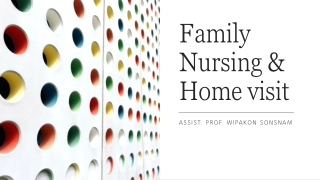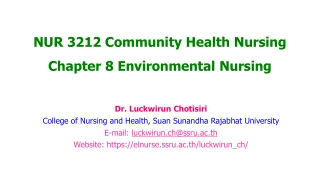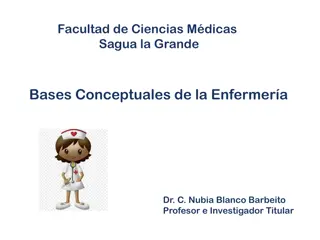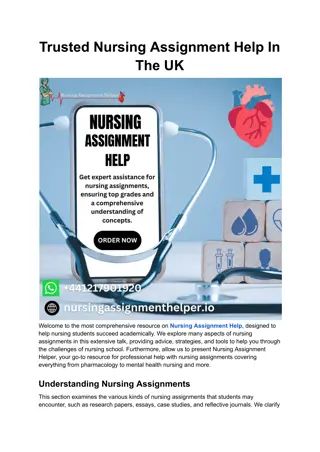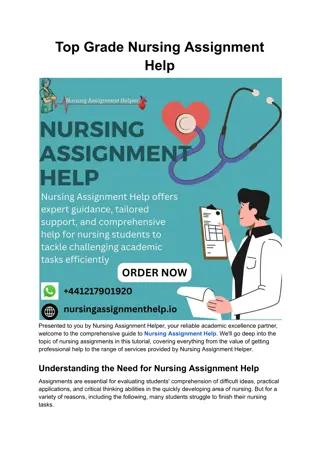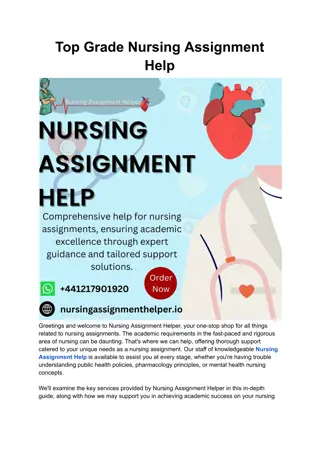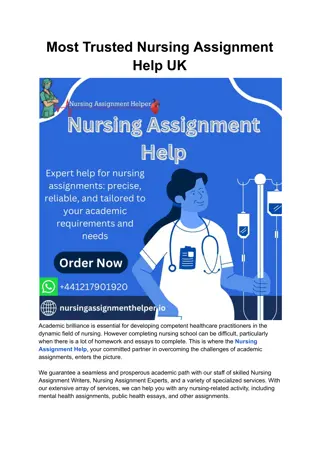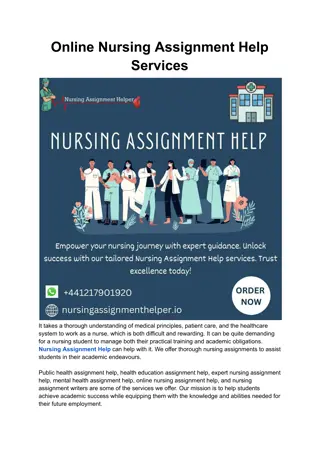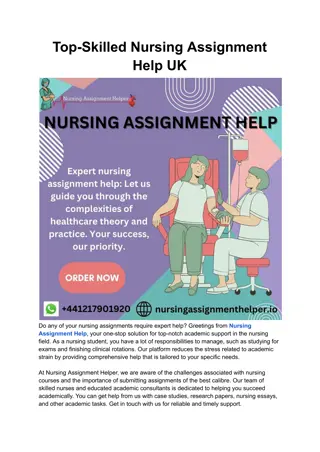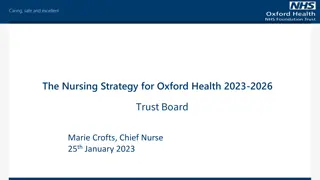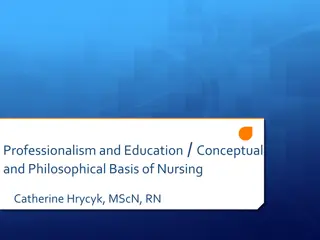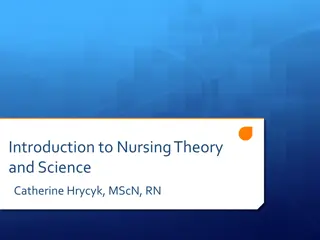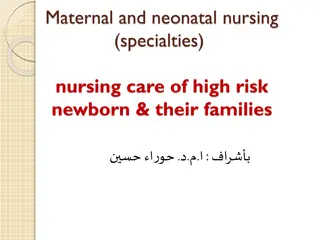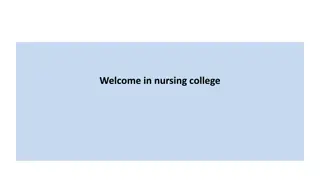
Understanding Family Health and Nursing Interventions
Explore the concept of family health, risks, and nursing roles in promoting well-being. Learn about the importance of family dynamics and interventions in healthcare settings.
Uploaded on | 0 Views
Download Presentation

Please find below an Image/Link to download the presentation.
The content on the website is provided AS IS for your information and personal use only. It may not be sold, licensed, or shared on other websites without obtaining consent from the author. If you encounter any issues during the download, it is possible that the publisher has removed the file from their server.
You are allowed to download the files provided on this website for personal or commercial use, subject to the condition that they are used lawfully. All files are the property of their respective owners.
The content on the website is provided AS IS for your information and personal use only. It may not be sold, licensed, or shared on other websites without obtaining consent from the author.
E N D
Presentation Transcript
Done Done by: by:Nosyba Heba Zakaria Nosyba Salem Heba Esam Zakaria Salem Esam
- Introduction - Definition of the family . - Function of the family . - Family health . - Determinants of healthy . - Family risks . - Nursing role and intervention. - summary/conclusion . - Evidence based practice . - References .
By the end of this seminar the student will be able to :- 1. Define the family concept . 2. Determine family health risk . 3. Discuss family health risk . 4. Recognize nursing role and interventions .
- The family is the unit of service in all health care delivery. - The health of one member affects the welfare of other members in the family. - Every family is unique and it is affected by every aspect of community life. - The health service providers has to understand family ways, traditions, customs and beliefs of the family.
GROUP OF PERSON UNITED BY TIES OF BLOOD, MARRIAGE OR ADOPTION INTERACTING & COMMUNICATING WITH EACH OTHER IN THEIR RESPECTIVE SOCIAL ROLES GROUP OF PERSON UNITED BY TIES OF BLOOD, MARRIAGE OR ADOPTION INTERACTING & COMMUNICATING WITH EACH OTHER IN THEIR RESPECTIVE SOCIAL ROLES
https://encrypted-tbn1.gstatic.com/images?q=tbn:ANd9GcQXcrRSOnhgJ3Hp-CJCZWpIH3pj5Rt1zWtEPl3EXyKxcWmVHAIQmQhttps://encrypted-tbn1.gstatic.com/images?q=tbn:ANd9GcQXcrRSOnhgJ3Hp-CJCZWpIH3pj5Rt1zWtEPl3EXyKxcWmVHAIQmQ - Socialization of family members. - economic stability. - care of dependent members. - emotional support for members. - satisfy social, intellectual, emotional and psychological needs of members.
Cont - Teaches children rules for behaviour and socially approved conduct. - Sickness role, interactions among family members in health, disease, counselling and rehabilitation
Family health is a dynamic, changing, relative state of well-being which includes the biological, psychological ,spiritual , sociological, and culture factors of the family system . https://encrypted-tbn3.gstatic.com/images?q=tbn:ANd9GcRpBd010MXr67z6lvSF2tvdwe-MBcivpW8_bavNORwSZY0b5fsyZw
FAMILY HEALTH CARE NURSING FAMILY HEALTH CARE NURSING Defined as the process of providing for health care needs of families that are within the scope of nursing practice . ANCY KURIAN , I MSc.(N) 9 8/25/2025
- Living and working conditions - Physical environment, - Psycho-social environment - Education and economic factors - health practices - Cultural factors - Gender etc.
Family health risks Economic/ occupational Psychological Social Biological - Low economic status . - Unemployment . - Suicide . - Drug abuse . - - DM - HTN - Cancer Violence - Divorce
- 347 million people worldwide have diabetes. - In 2004, an estimated 3.4 million people died from consequences of high fasting blood sugar . - More than 80% of diabetes deaths occur in low- and middle-income countries. - WHO projects that diabetes will be the 7th leading cause of death in 2030.
Why do we consider diabetes as a family health risks ? Family history of diabetes is recognized as an important risk factor of the disease. Individuals who have a family history of diabetes can have two to six times the risk of diabetes compared with individuals with no family history of the disease . family medical history provides valuable genomic information because it represents the combination of inherited genetic susceptibilities and shared environmental and behavioral factors . The use of family history as part of a comprehensive risk assessment for an individual can be crucial in the prevention, early detection, and treatment of diabetes. Why do we consider diabetes as a family health risks ?
Worldwide, raised blood pressure is estimated to cause 7.5 million deaths, about 12.8% of the total of all deaths. globally, the overall prevalence of raised blood pressure in adults aged 25 and over was around 40% in 2008.
- 8.2 million people worldwide died from cancer in 2012. - 60% of world s total new annual cases occur in Africa, Asia and Central and South America . - 30%of cancers could be prevented .
- Cancer prevention At least one-third of all cancer cases are preventable. As a nurse : - Physical inactivity, dietary factors, obesity and being overweight - Alcohol use. - Infections . - Environmental pollution . - Occupational carcinogens . - Radiation . https://encrypted-tbn3.gstatic.com/images?q=tbn:ANd9GcRzL7hfKrQM7DTc5lwB-Ax4BMNtiB3728V9oOjz8eXK32gxrBXLCQ
Why do we consider suicide as a family health risks ? Why do we consider suicide as a family health risks ?
Violence : threatened or actual, against oneself, another person, or against a group or community, which either results in or has a high likelihood of resulting in injury, death, psychological harm, maldevelopment, or deprivation . Violence : is the intentional use of physical force or power,
Facts about violence : - Each year, nearly 1.4 million people worldwide lose their lives to violence. For every person who dies as a result of violence, many more are injured and suffer from a range of physical, sexual, reproductive and mental health problems. - Violence places a massive burden on national economies, costing countries billions of US dollars each year in health care, law enforcement and lost productivity.
Nine Types of Violence and Abuse Physical Violence Physical violence occurs when someone uses a part of their body or an object to control a person s actions. Sexual Violence Sexual violence occurs when a person is forced to unwillingly take part in sexual activity. Emotional Violence Emotional violence occurs when someone says or does something to make a person feel stupid or worthless. Psychological Violence Psychological violence occurs when someone uses threats and causes fear in an individual to gain control. Spiritual Violence Spiritual (or religious) violence occurs when someone uses an individual s spiritual beliefs to manipulate, dominate or control that person. Cultural Violence Cultural violence occurs when an individual is harmed as a result of practices that are part of her or his culture, religion or tradition. Verbal Abuse Verbal abuse occurs when someone uses language, whether spoken or written, to cause harm to an individual. Financial Abuse Financial abuse occurs when someone controls an individual s financial resources without the person s consent or misuses those resources. Neglect Nine Types of Violence and Abuse Physical Violence Sexual Violence Emotional Violence Psychological Violence Spiritual Violence Cultural Violence Verbal Abuse Financial Abuse Neglect
violence is preventable and its impacts can be reduced address underlying causes such as low levels of education, harsh and inconsistent parenting, concentrated poverty, unemployment and social norms supportive of violence. - - violence prevention programmes in schools . - - Promoting positive, nurturing relationships within families can prevent violence . - - Community programmes can play a role in preventing violence . - - Societies can prevent violence by reducing risks such as alcohol, guns, and economic and gender inequality . violence is preventable and its impacts can be reduced : violence prevention programmes in schools . Promoting positive, nurturing relationships within families can prevent violence . Community programmes can play a role in preventing violence . Societies can prevent violence by reducing risks such as alcohol, guns, and economic and gender inequality .
https://encrypted-tbn3.gstatic.com/images?q=tbn:ANd9GcRZhfcqZqzbDDcNeRdYegQ5-VEZgWWL0ZDiaTPmJlt26X4NNuibqghttps://encrypted-tbn3.gstatic.com/images?q=tbn:ANd9GcRZhfcqZqzbDDcNeRdYegQ5-VEZgWWL0ZDiaTPmJlt26X4NNuibqg
. 2004 2008 . 309722 . 13218
- Divorce is the legal breakup of a marriage. Like every major life change, divorce is stressful. It affects finances, living arrangements, household jobs, schedules, and more. If the family includes children, they may be deeply affected . Factors contribute to divorce : - - Financial Difficulties - - Work Stress and Obligations - - Education Level - - Parents' Divorces (past experience) - - Age Difference Between Spouses . - - Ineffective communication . Financial Difficulties Work Stress and Obligations Education Level Parents' Divorces (past experience) Age Difference Between Spouses . Ineffective communication .
As a nurse what we can do : - Help to identify couples at risk . - provide couples skills training for ( conflict management , effective way of communication , stress management , anger management ) . - Seeking consultation from expertise before making the divorcing decision . - Divorce should be the last choice .
- Behavior and conduct Boys disruptive, delinquency, sub. Abuse Girls - Social relationships . - Poorer psychological adjustment . - Relationship with parents: conflict, attention-seeking . - Poorer school performance . Boys: externalizing : aggression, hyperactivity, Girls: internalizing": anxiety, depression, withdrawal. https://encrypted-tbn0.gstatic.com/images?q=tbn:ANd9GcQz2JGLLxBpvVpaGmZwL_2S8KzGnP7IuGoxp8-33x0YTnnQR68s
Definition : Unemployment occurs when a person who is actively searching for employment is unable to find work. Unemployment is often used as a measure of the health of the economy. Factors that contribute to unemployment : - Rapid changes in technology - Inflation - Disability - Changes in tastes as well as alterations in the climatic conditions. This may in turn lead to decline in demand for certain services as well as products. Definition : Unemployment occurs when a person who is actively searching for employment is unable to find work. Unemployment is often used as a measure of the health of the economy. https://encrypted-tbn1.gstatic.com/images?q=tbn:ANd9GcSb18WD_DsJBepgOI4Nm6eWQedwxRvOTTqxxuJ8H2SOOwWKkTxU
Cont - Attitude towards employers - Willingness to work - Employee values - Discriminating factors in the place of work (may include discrimination on the basis of age, class, ethnicity, color and race). - Ability to look for employment
*Consequences of unemployment : - symptoms of somatization, depression, and anxiety were significantly greater in the unemployed than employed. - Low self esteem. unemployed made significantly more visits to their physicians, took more medications, and spent more days in bed sick than did employed individuals . As a nurse what we can do???
Finally family risk are wide title as a nurse remember that we can at least help to pass safely through these risks https://encrypted-tbn3.gstatic.com/images?q=tbn:ANd9GcRxLT0Bie1IMsWhdhgd_iawbrEA8KZzstFdVc8vyom5F_BLsLV7 Working with families helps families live alongside illness and increase their sense of wellness.
1. www.who.org 2. www.cdc.org 3. Shirley May Harmon Hanson. Family Health Care Nursing, 2nded. Philadelphia: F.A Davia Publishers; 2001.p. 4-19. 4. www.googlescolar.jo
ANCY KURIAN , I MSc.(N) 46 8/25/2025

